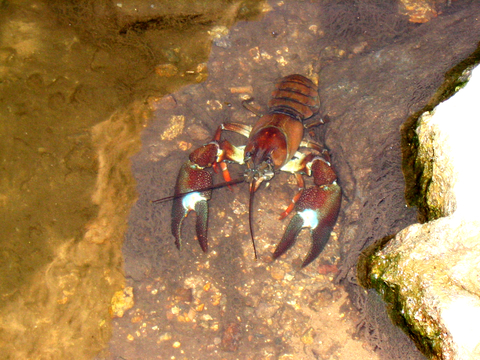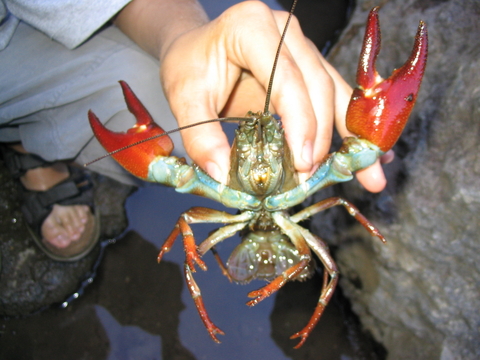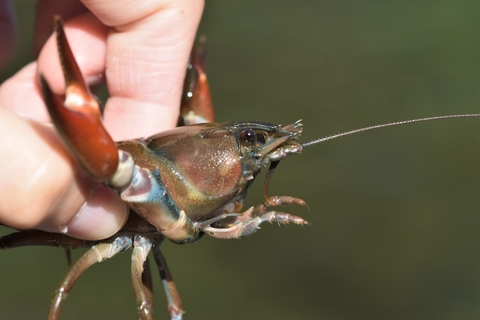Minnesota Department of Natural Resources recently announced the discovery of invasive signal crayfish (Pacifastacus leniusculus) in Lake Winona, near Alexandria, Minnesota. Signal crayfish are native to the Pacific Northwest region of North America, but invasive populations have been found outside that range in California as well as in parts of Europe. Learn more about this new invasive species here.
What do they look like?
Signal crayfish are typically reddish-brown in color with bright red under the claws and a white or turquoise patch on top at the claw hinge. This patch is variable in color and size but is distinctive to this species and is also where it gets its name as it resembles a signal flag. The carapace and claws are smooth, other than two sharp spines behind the eyes, which is a good differentiation between the signal crayfish and other crayfish you can find in Minnesota.
What are the impacts?
With a lifespan of up to 20 years and a production of 200-400 eggs per cycle, signal crayfish have the reproductive capacity to become a dominant species in introduced areas. This species grows faster and is larger than our native crayfish (up to 7 inches long and 4 ounces in weight) and they aren’t fussy about habitat. Signal crayfish can be found in streams, rivers, lakes and wetlands. They are opportunistic omnivores and eat whatever they can find, including fish eggs, smaller crayfish and native plants.
We also know that signal crayfish can carry crayfish plague but are resistant to it themselves. This means introduction to a new location can also introduce disease to native populations while not reducing the invading signal crayfish numbers. From currently invaded ranges, we know that the aggressive signal crayfish can outcompete fish and other animals from suitable habitats and food, which has likely contributed to the extinction of a native crayfish in California.
What does this mean for Minnesota?
The honest answer is, we’re not sure yet. This is the first time this species has been reported in North America east of the Rocky Mountains. Luckily, the crayfish found in Lake Winona are not thought to be reproducing and the DNR will continue to monitor in the spring, but it is too early to tell how many are still in the lake and if any others might be breeding. With its ability to thrive in a variety of water types, prolific breeding ability, aggressiveness, and discovery in a climate close to its native and invaded range, some sources believe signal crayfish could become established in Minnesota.
How do they spread?
While we don’t know how the crayfish found in Lake Winona got there, crayfish are often spread by illegal release from aquariums, classroom pets, fishing bait, and after crayfish boils. It is illegal in Minnesota to import crayfish without a permit and is illegal to release non-native animals into the environment. Signal crayfish can also move across land at night or during wet weather.
What can I do?
Learn more about signal crayfish on the DNR website and the USGS website. As you are exploring Minnesota lakes, rivers and streams, pay attention to any crayfish you find. Other invasive crayfish of concern in Minnesota include rusty crayfish and red swamp crayfish. You can explore our AIS Identification Guide for more information on how to tell these two invasive crayfish apart from common native crayfish species in Minnesota.
If you think you’ve found an invasive crayfish, take photos, document where you found it, and report it via EDDMapS or by contacting a local DNR AIS Specialist. If you’d like to preserve the specimen for DNR to identify, place it in an enclosed container.




